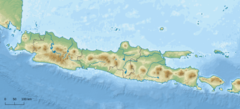The Comal River is a river in Jawa Tengah, Indonesia.[1][2] It rises in the North Serayu Mountains from Mount Slamet. The river has a length of around 109.18 km flowing from south to north, ending in Java Sea. It is the largest river in Pemalang Regency, Central Java, and flows through seven districts within that regency.[3]
| Sungai Comal Kali Comal, Kali Tjomal | |
|---|---|
 | |
| Location | |
| Country | Indonesia |
| Province | Jawa Tengah |
| Physical characteristics | |
| Source | Gunung Slamet |
| Mouth | Laut Jawa |
• coordinates | 6°46′36″S 109°31′18″E / 6.7767°S 109.5217°E |
| Length | 109.18 km (67.84 mi) |
| Basin size | 822 km2 (317 sq mi) |
| Basin features | |
| River system | Comal basin |
| Basin Management | BPDAS Pemali-Jratun |
Geography
editThe river flows along the central north area of Java with a predominantly tropical monsoon climate. The annual average temperature in the area is 25 °C. The warmest month is September, when the average temperature is around 29 °C, and the coldest is March, at 22 °C.[4] The average annual rainfall is 2758 mm. The wettest month is January, with an average of 492 mm rainfall, and the driest is September, with 23 mm rainfall.[5]
Hydrology
editThe Comal River is the main stream in the drainage basin (Indonesian: daerah aliran sungai (DAS) Comal covering an area of 822 km2 (317 sq mi)[6] which comprises three administrative regencies: Pemalang, Tegal and Pekalongan.[7] The upstream is located at the border between the villages of Batursari and Penakir in the district of Pulosari and flowing to Java Sea.
Tributaries
editSome main tributaries of the Comal River are:
- Paingen River
- Gronggang River
- Paku River
- Wakung River
- Lumeneng River
- Polaga River
- Layangan River
- Keruh River
Uses
editThe inhabitants along the Comal River use the water for agriculture and fisheries, either by traditional fishing or with nets. The downstream is wide enough for small fishermen's boats to sail. The high discharge of the river is used for irrigation passing some gates or dams, such as Mejagong and Sukowati Dams. The downstream area is a popular destination for rafting.[8]
See also
editReferences
edit- ^ Rand McNally, The New International Atlas, 1993.
- ^ Kali Comal at Geonames.org (cc-by); Last updated 4 June 2013; Database dump downloaded 27 November 2015
- ^ Kantor Statistik Kabupaten Pemalang (2008). Pemalang dalam Angka 2008, Pemerintah Kabupaten Daerah Tk. II Pemalang, BPS. Hlm. 246.
- ^ "NASA Earth Observations Data Set Index". NASA. 30 January 2016. Archived from the original on 10 May 2020. Retrieved 2 December 2018.
- ^ "NASA Earth Observations: Rainfall (1 month – TRMM)". NASA/Tropical Rainfall Monitoring Mission. 30 January 2016. Archived from the original on 19 April 2019. Retrieved 2 December 2018.
- ^ Hukum Online. "Keputusan Menteri Kehutanan No. SK.511/MENHUT-V/2011" (in Indonesian).
- ^ Daerah Aliran Sungai Comal
- ^ "Mencicipi Ekstremnya Jeram Hulu Sungai Comal Di Pemalang". Archived from the original on 19 December 2017. Retrieved 2 December 2018.
